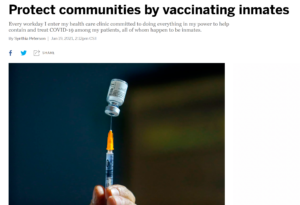
Every workday I enter my health care clinic committed to doing everything in my power to help contain and treat COVID-19 among my patients, all of whom happen to be inmates. I am one of tens of thousands correctional nurses nationwide working behind the walls in some of the largest congregate settings in the U.S. There is an urgent need to include workplaces like mine in planning and execution of vaccine distribution.
In Colorado, a recently released, revised version of the state’s vaccination plan eliminates incarcerated individuals from any particular vaccine phase because of the perceived controversy of vaccinating inmates before the public. To those outside of correctional health care it is understandable. But the facts make this decision an unfortunate one.
Vaccinating incarcerated individuals and those caring for these populations is an important step in protecting our communities – one The American Medical Association views as a top priority. Unlike long-term care facilities, jails and prisons have an ever changing population. Inmates, correctional officers and medical personnel work in close quarters and sometimes under extremely challenging circumstances. Correctional officers and nurses such as me go back out into the community after every shift. Vendors come in and out constantly. Visitations from inmate family members or attorneys, where they still occur in person, present another challenge.
But one of the biggest challenges is when an inmate is released. Sadly, a released inmate is very unlikely to receive health care outside the correctional setting. Symptoms of COVID-19 will go unchecked and illness maybe untreated for days, if not weeks. In addition, as inmates return to the community, contact tracing is extremely difficult – some do not have a required address, some move from location to location, many don’t have a driver’s license or a phone number. Many work multiple jobs and interact with a wide variety of people in multiple different settings each day. These released inmates can easily become super-spreaders. If the immediate goal is to contain the virus, then vaccinating those in our jails and prisons is critical.
I’ve provided care in prisons for 25 years and am deeply committed to my patients. We are not looking for special treatment when it comes to vaccines. We are asking for people to understand the unique nature of the challenge we face and the urgent need to include inmates as a priority in vaccine distribution planning. States like Massachusetts – where inmates will be among the first vaccinated – understand the urgent need to vaccinate these vulnerable populations and are heeding the guidance of the Centers for Disease Control which lists correctional officers and inmates as critically important priorities. Here in Illinois and Cook County, there is a keen understanding of the challenge and demands right now. But the reaction of the public to the issue of correctional vaccination can often be deeply negative and skeptical. It’s an understandable reaction, but one that I hope people come to see as self-defeating. I am not making a moral argument here – although I can certainly do that. Rather, self-interest is best served by a careful inclusion of jails, prisons, correctional officers and health professions that service and protect inmates in any vaccination plan.
Synthia Peterson is a registered nurse and regional manager for Wellpath. She is an Illinois resident and has worked in correctional health care for 25 years.
Protect communities by vaccinating inmates [chicago.suntimes.com]